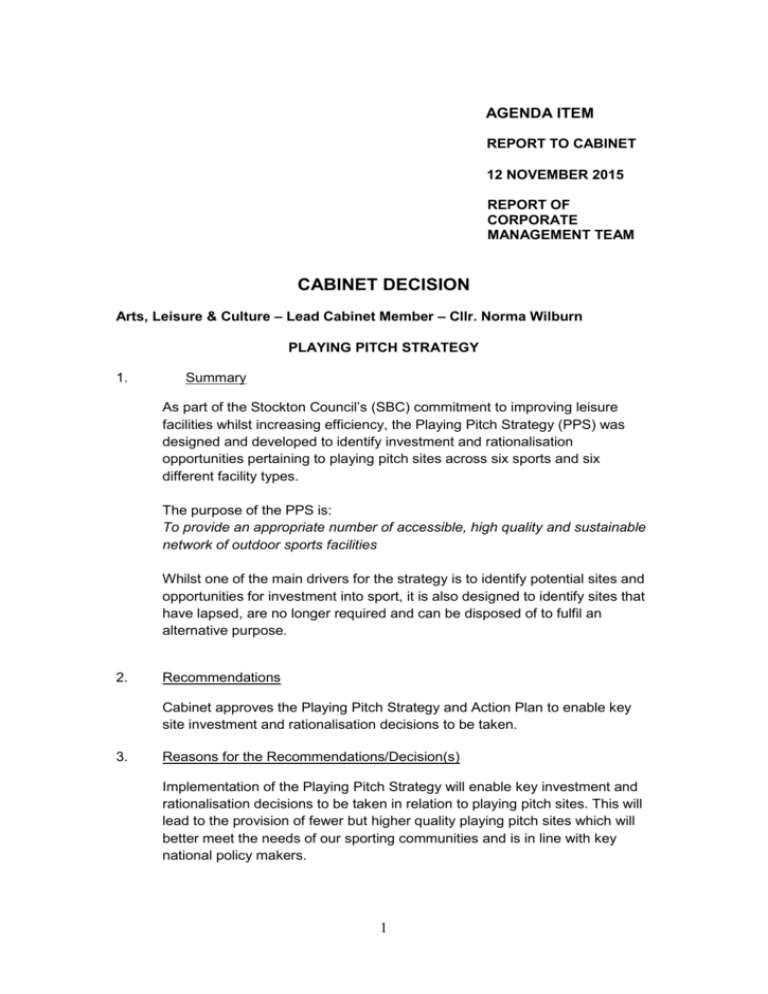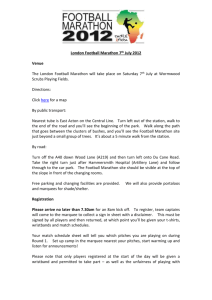Report - Stockton-on-Tees Borough Council
advertisement

AGENDA ITEM REPORT TO CABINET 12 NOVEMBER 2015 REPORT OF CORPORATE MANAGEMENT TEAM CABINET DECISION Arts, Leisure & Culture – Lead Cabinet Member – Cllr. Norma Wilburn PLAYING PITCH STRATEGY 1. Summary As part of the Stockton Council’s (SBC) commitment to improving leisure facilities whilst increasing efficiency, the Playing Pitch Strategy (PPS) was designed and developed to identify investment and rationalisation opportunities pertaining to playing pitch sites across six sports and six different facility types. The purpose of the PPS is: To provide an appropriate number of accessible, high quality and sustainable network of outdoor sports facilities Whilst one of the main drivers for the strategy is to identify potential sites and opportunities for investment into sport, it is also designed to identify sites that have lapsed, are no longer required and can be disposed of to fulfil an alternative purpose. 2. Recommendations Cabinet approves the Playing Pitch Strategy and Action Plan to enable key site investment and rationalisation decisions to be taken. 3. Reasons for the Recommendations/Decision(s) Implementation of the Playing Pitch Strategy will enable key investment and rationalisation decisions to be taken in relation to playing pitch sites. This will lead to the provision of fewer but higher quality playing pitch sites which will better meet the needs of our sporting communities and is in line with key national policy makers. 1 4. Members’ Interests Members (including co-opted Members) should consider whether they have a personal interest in any item, as defined in paragraphs 9 and 11 of the Council’s code of conduct and, if so, declare the existence and nature of that interest in accordance with and/or taking account of paragraphs 12 - 17 of the code. Where a Member regards him/herself as having a personal interest, as described in paragraph 16 of the code, in any business of the Council he/she must then, in accordance with paragraph 18 of the code, consider whether that interest is one which a member of the public, with knowledge of the relevant facts, would reasonably regard as so significant that it is likely to prejudice the Member’s judgement of the public interest and the business: affects the members financial position or the financial position of a person or body described in paragraph 17 of the code, or relates to the determining of any approval, consent, licence, permission or registration in relation to the member or any person or body described in paragraph 17 of the code. A Member with a personal interest, as described in paragraph 18 of the code, may attend the meeting but must not take part in the consideration and voting upon the relevant item of business. However, a member with such an interest may make representations, answer questions or give evidence relating to that business before the business is considered or voted on, provided the public are also allowed to attend the meeting for the same purpose whether under a statutory right or otherwise (paragraph 19 of the code) Members may participate in any discussion and vote on a matter in which they have an interest, as described in paragraph18 of the code, where that interest relates to functions of the Council detailed in paragraph 20 of the code. Disclosable Pecuniary Interests It is a criminal offence for a member to participate in any discussion or vote on a matter in which he/she has a disclosable pecuniary interest (and where an appropriate dispensation has not been granted) paragraph 21 of the code. Members are required to comply with any procedural rule adopted by the Council which requires a member to leave the meeting room whilst the meeting is discussing a matter in which that member has a disclosable pecuniary interest (paragraph 22 of the code) 2 AGENDA ITEM REPORT TO CABINET 12 NOVEMBER 2015 REPORT OF CORPORATE MANAGEMENT TEAM CABINET DECISION THE STOCKTON-ON-TEES PLAYING PITCH STRATEGY SUMMARY 1. As part of the Stockton Council’s (SBC) commitment to improving leisure facilities whilst increasing efficiency, the Playing Pitch Strategy (PPS) was designed and developed to identify investment and rationalisation opportunities pertaining to playing pitch sites across six sports and six different facility types. 2. The purpose of the PPS is: To provide an appropriate number of accessible, high quality and sustainable network of outdoor sports facilities 3. Whilst one of the main drivers for the strategy is to identify potential sites and opportunities for investment into sport, it is also designed to identify sites that have lapsed, are no longer required and can be disposed of to fulfil an alternative purpose. RECOMMENDATIONS 4. Cabinet approves the Playing Pitch Strategy and Action Plan to enable key site investment and rationalisation decisions to be taken. DETAIL 5. The Strategy provides a clear, strategic framework for the maintenance and improvement of existing outdoor sports pitches and ancillary facilities between 2015 and 2025. The purpose of the PPS is to help us to prioritise and target resources where resources are limited. 3 6. The PPS covers the following playing pitches and outdoor pitch sports: Football pitches Cricket pitches Rugby union pitches Rugby league pitches Artificial grass pitches (AGPs) Bowling greens Tennis courts 7. The Strategy is capable of: Providing adequate planning guidance to assess development proposals affecting playing fields, as appropriate, directing open space contributions secured through development and informing and shaping local planning policy. Inform the protection and provision of sports facilities and the Infrastructure Delivery Plan and S106 and CIL schedules. Informing land use decisions in respect of future use of existing playing fields (capable of accommodating pitches) across the borough; Providing a strategic framework for the provision and management of playing pitches across the borough; Supporting external funding bids and maximise support for playing pitch facilities; Providing the basis for on-going monitoring and review of the use, distribution, function, quality and accessibility of playing pitches 8. In order to comply with the planning for sport framework of Sport England, the three main aims of the strategy reflect Sport England’s planning aim and objectives for sport. They are: AIM 1 - To protect the existing supply of sports facilities where it is needed for meeting current or future needs AIM 2 - To enhance outdoor sports facilities through improving quality and management of sites AIM 3 - To provide new outdoor sports facilities where there is current or future demand to do so 9. The following Strategic recommendations underpin the identified three mains aims: AIM 1 a. Protect sports facilities where there is a need to do so through local planning policy. 4 b. Secure tenure and access to sites for high quality, development minded clubs, through a range of solutions and partnership agreements. c. Maximise community use of outdoor sports facilities where there is a need to do so. d. Consider disposal of sites identified as surplus ensuring that where appropriate a portion of the capital receipt from land sales is secured for improving remaining strategic sites. AIM 2 e. Improve quality f. Adopt a tiered approach (hierarchy of provision) for the management and improvement of sites. g. Work in partnership with stakeholders to secure funding AIM 3 h. Rectify quantitative shortfalls in the current pitch stock. i. Identify opportunities to add to the overall stock to accommodate both current and future demand. Key Issues/ Opportunities for Stockton-on-Tees 10. The Strategy identifies each site across the borough in each of the identified sports and proposes recommended actions for each of these sites that should be implemented where possible over the life of the Strategy (2015-2025). Although the strategy covers facilities across seven sports and identifies many opportunities and challenges, the key opportunities and challenges relate to the provision of football pitches. This is not to deny the importance of the other sports merely reflecting the numbers participating and the financial impact upon SBC. 11. The borough has sufficient pitches to accommodate the sports pitch needs of our residents. However a number of these sites cannot be considered to be in secured community use as they sit on school sites and usage is at the discretion of the school and its governing body. That said with the rebuilding of a number of secondary school sites including Ian Ramsey and St Michael sites previously not available to the community will become available. 12. Key Action 1: In support of AIM 1(b) SBC will continue to work with schools to secure greater access as required. This will increase the number of available high quality playing pitch sites for Junior/ adult football without any additional SBC in investment. 5 FA Hub-Sites Case Study – Sheffield City Council 13. Hub-Sites – Hub-Sites are sites where teams attend a central venue as opposed to all teams playing on a home and away basis. 14. Like many local authorities Sheffield City Council is under significant pressure to not only provide sports facilities for local residents but to also enhance existing provision, whilst at the same time attempting to manage huge budget reductions. 15. Following successful delivery of the Sheffield PPS, KKP, in partnership with the FA and Sheffield City Council, has taken a radical look at how the game of football is played within the City and how a more sustainable model of provision, both in quality and quantity, could be achieved against this challenging financial backdrop. 16. The main outcome from the work was a focus on switching mini and youth football (U7-U12) from grass to artificial pitches and programming AGPs in such a way that they are used for longer and more often than the current capacity of grass pitches allows. KKP has created a programming formula that can be replicated across other local authorities; this reduces the need for grass provision and associated maintenance costs, as well as improving the quality of pitches for all players. This approach also ensures that lapsed sites can be disposed of and additional investment placed into improving the remaining sites. 17. Across Stockton-on-Tees there is currently an over provision of adults grass pitches and an under provision of grass youth and mini pitches to meet demand. However in line with the FA drive to increase usage of artificial grass pitches (AGP’s) for junior football, Stockton-on-Tees as a borough has four AGP’s (soon to have five) and as such is well placed to meet the needs of junior football clubs both now and in the future. 18. Upon completion of the planned AGP at Stockton Sixth Form College, the borough will have five AGP’s capable of hosting competitive football. This provision will mitigate the current short-falls in mini/ junior provision and reduce the requirement for grass pitches. 19. There is a challenge in this in that old habits die hard and migration from grass to AGP’s may not happen as seamlessly as we would like. However based on the Sheffield example we are confident that once teams start to migrate and the quality of the playing surface of AGP’s is recognised by junior clubs, then migration of the majority will follow. 20. Key Action 2A: To deliver a fifth AGP at Stockton 6th Form college. This will ensure that the FA’s aspiration for competitive mini/ youth football can be effectively delivered within Stockton-on-Tees along with providing additional capacity to support competitive junior/ adult football as required. 6 21. Key Action 2B: To work with the FA, Sport England and the junior football league (Teesside Junior Football Alliance) to support a migration of mini and youth football from grass onto AGP’s as soon as is possible. 22. Migrating mini/ junior football from grass onto AGP’s and opening up school sites will increase the number of grass pitches (and associated infrastructure, i.e. changing facilities) available. As a consequence of this action it will enable sites that have lapsed or of relatively poor quality to be taken out of circulation. The sites we consider to be lapsed or poor quality are as follows: Former Blakeston School – To be disposed of as per the Cabinet Report – May 2013. The Education Centre Former Norton School (Lapsed) Bluehall Recreation Ground Grangefield Recreation Ground Darlington Back Lane Recreation Ground Yarm Road Recreation Ground 23. Key Action 3: Develop plans for removing and/ or disposing of relevant sites above ensuring that some investment from any disposals is secured for improving existing playing pitch sites. FINANCIAL IMPLICATIONS 24. The adoption and delivery of the Playing Pitch Strategy Action Plan does not necessitate new money from SBC. Implementation of the Action Plan can achieve: The disposal of lapsed sites generating additional income for SBC through capital receipts. Improvement to existing priority sites through the development of an investment strategy. 25. Further detail is available within the Asset Review, School Capital and Site Disposal Paper. LEGAL IMPLICATIONS 26. N/A COUNCIL PLAN POLICY PRINCIPLES AND PRIORITIES 27. The report impacts upon the Policy Principles and Priorities in the Council Plan 7 Policy Principles: Promoting equality of opportunity through targeted intervention Developing strong and healthy communities Priorities: Environment and Housing Community Safety Children and Young People Health and Wellbeing Stronger Communities Adults Arts, Leisure & Culture Organisational and Operational Effectiveness CONSULTATION INCLUDING WARD/ COUNCILLORS 28. Significant consultation has taken place in the formulation of the Playing Pitch Strategy and further consultation will take place to inform how the Action Plan is to be implemented. Name of Contact Officer: Reuben Kench Post Title: Head of Culture, Leisure & Adult Learning Telephone No: 01642 527039 Email Address: reuben.kench@stockton.gov.uk 8








